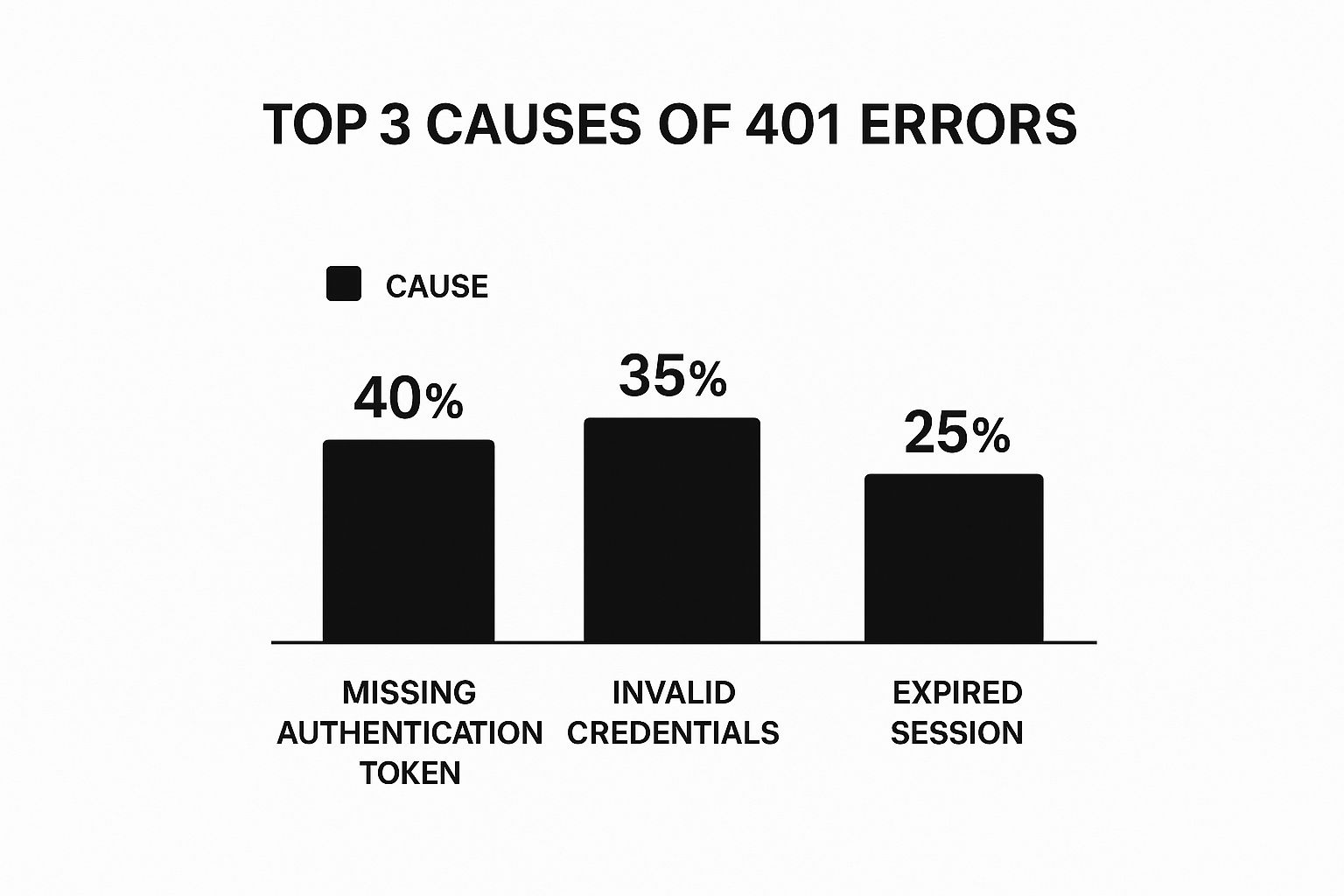Solving the HTTP Status Code 401 Unauthorized Error
When you run into an HTTP 401 Unauthorized error, it's the web server's way of saying, "Hold on, I don't know who you are." The request you sent didn't include the right credentials, so the server is blocking access until you can prove your identity.
Think of it like trying to get into a members-only lounge. If you walk up to the door without a membership card, the person at the entrance will stop you. They aren't saying you're banned forever; they're just telling you that you need to show valid proof of membership to get in. That’s a 401 error in a nutshell. It’s a client-side problem, meaning the issue is with your request, not a problem with the server itself.
Decoding the 401 Unauthorized Error
The 401 error is all about authentication—the process of verifying who you are. It's often confused with a 403 Forbidden error, but they're fundamentally different. A 401 means the server has no idea who you are, while a 403 means the server knows exactly who you are, but you still don't have permission to see the content.
It’s like the difference between being stopped at the front door for a ticket (authentication) versus being allowed in but barred from the VIP section (authorization). The 401 is that first checkpoint.
According to the official HTTP/1.1 specification, the 401 Unauthorized response must also include a WWW-Authenticate header. This header is incredibly helpful because it tells the client how to authenticate. It’s the server’s way of saying, "You need to provide a username and password," or "You need to present a Bearer token." For a deeper dive into the technical specifics, the guide on 401 errors on Rush Analytics is a great resource.
Key Characteristics of a 401 Error
So, what are the defining traits of this error? Understanding these points makes it much easier to diagnose the problem, whether you're a developer working on an API or just someone trying to log into a website.
- It’s a client-side issue: The responsibility falls on the client (your browser or application) to send the correct credentials. The server is working just fine.
- Authentication is the missing piece: The server needs to verify your identity but hasn't received the information it needs.
- It’s not a permanent rejection: A 401 is a prompt to try again. Provide the right credentials, and you'll likely get in.
- The
WWW-Authenticateheader is your guide: This header is the server's instruction manual for how to properly authenticate on the next try.
To boil it all down, here's a quick reference table that breaks down the essentials of a 401 Unauthorized error.
| HTTP 401 Unauthorized Error at a Glance | |
|---|---|
| Attribute | Description |
| Error Code | 401 Unauthorized |
| Error Type | Client-Side |
| Core Problem | Authentication Failure. The server doesn't know who is making the request. |
| Key Header | WWW-Authenticate. This response header specifies the authentication method(s) required. |
| Is it permanent? | No. It's a temporary block that can be resolved by resending the request with valid credentials. |
| Common Scenarios | Missing API key, expired session token, incorrect username/password, or malformed credentials. |
This table gives you a clear, at-a-glance summary of what a 401 error really means and why you might be seeing it.
What's Really Causing That 401 Error?

Running into an HTTP status code 401 can feel like hitting a brick wall, but it's rarely a dead end. In most cases, the problem boils down to a few common mix-ups in how your app is trying to prove its identity to the server.
Think of it like a troubleshooting checklist. The error is the symptom, and your job is to trace it back to the source. The good news is that the culprit is often something simple, like a typo, though it can occasionally point to a deeper issue in your application's sign-in process.
Invalid or Incorrect Credentials
This is, by far, the most common reason you'll see a 401. It's the digital version of fumbling your keys at the front door. The server gets the request, checks the credentials you sent, and simply can't find a match.
Here are a few ways this plays out:
- Misspelled Usernames or Passwords: We've all been there. One tiny typo is enough to get rejected.
- Outdated Credentials: The user changed their password, but their browser or app is still trying to use the old, saved one.
- Incorrect API Keys: When working with APIs, it's easy to grab the wrong key. You might be using a key from your test environment in production, or the key might have been revoked.
A 401 error is the server's way of saying, "Authentication is required here, and what you gave me didn't work." It's essentially a challenge: "Prove who you are before you can come in."
Expired or Invalid Tokens
Modern apps don't just rely on a username and password for every single request. Instead, they often use temporary tokens, like JSON Web Tokens (JWTs) or session cookies. These are like a temporary backstage pass—they work great, but they have an expiration date.
Once that token expires, the server won't honor it anymore, triggering a 401 Unauthorized response. This isn't a bug; it's a crucial security feature. It limits the amount of time an attacker has to use a stolen token. When this happens, the application needs to get a fresh token, usually by asking the user to log in again. Handling this gracefully is a critical part of the process when you test REST APIs, ensuring users aren't just left staring at an error screen.
Missing Authentication Information
Sometimes the problem isn't that your credentials are wrong—it's that they're completely missing. The client makes a request to a protected endpoint but forgets to include any authentication details in the Authorization header.
The server sees this request for a private resource, notices the empty hands, and has no choice but to send back a 401. This is the server's way of prompting the client to try again, but this time with the right credentials. It's a classic slip-up, often happening when a developer overlooks attaching the auth token to a new API call.
Understanding 401 Unauthorized vs. 403 Forbidden
At first glance, a 401 Unauthorized error and a 403 Forbidden error seem pretty similar. Both stop you cold, blocking access to whatever you were trying to reach. But dig a little deeper, and you'll find they happen for completely different reasons. Getting them mixed up can send you down a rabbit hole during debugging, so let's clear up the confusion.
The entire difference comes down to one core concept: authentication versus authorization.
Imagine you’re trying to get into a members-only club. A 401 Unauthorized is like the bouncer at the front door stopping you because you haven't shown any ID. They have no idea who you are, so you can't come in. The solution? Show them your membership card.
Now, let's say you show your valid ID, and the bouncer lets you into the main area. But when you try to get into the exclusive VIP lounge upstairs, another guard stops you. They check your ID, see your name, but then shake their head—your membership level doesn't grant you access to this specific room. That’s a 403 Forbidden error. They know exactly who you are, but you just don’t have the right permissions.
Authentication vs. Authorization: The Core Difference
This simple analogy gets right to the heart of what these status codes mean.
A 401 Unauthorized response is an authentication problem. The server is basically saying, "I don't know who you are. Prove your identity with valid credentials."
A 403 Forbidden response is an authorization problem. Here, the server is saying, "I know who you are, but you aren't allowed to do that or see this."
This means a 401 is a prompt to try again, maybe with the right password or a fresh API token. A 403, on the other hand, is a dead end. Sending your credentials again won’t help because the problem isn't your identity—it's your permissions.
This infographic really drives home the point by showing the most common triggers for 401 errors, all of which boil down to authentication failures.

As you can see, a whopping 75% of 401 errors are caused by a missing authentication token or simply providing the wrong credentials. It’s a classic gatekeeper error.
To make this distinction crystal clear, here’s a side-by-side comparison.
Comparing HTTP 401 Unauthorized and 403 Forbidden
| Aspect | HTTP 401 Unauthorized | HTTP 403 Forbidden |
|---|---|---|
| Problem | Authentication (Who are you?) | Authorization (What can you do?) |
| Server's Message | "You need to log in or provide valid credentials to access this." | "I know who you are, but you don't have permission to be here." |
| Typical Cause | Missing, invalid, or expired credentials (API key, password, token). | Correct credentials but insufficient user rights or permissions. |
| Can It Be Resolved? | Yes, by providing correct credentials and re-authenticating. | No, not by resending the same credentials. It requires a change in permissions. |
| Real-World Analogy | Being stopped at the main entrance for not showing an ID. | Being allowed in but blocked from entering a restricted area. |
| Common Scenario | A user tries to access their profile page without being logged in. | A standard user tries to access an admin-only control panel. |
Understanding this table is key to building logical, secure applications that communicate clearly with both users and other systems.
Why This Matters in API Design
Using the right status code isn't just about being technically correct; it's crucial for building APIs that are secure and easy for other developers to work with.
Sending the wrong code can be misleading. For example, if a logged-in user tries to sneak a peek at another user's private account data, sending a 401 would be wrong. The user is already authenticated! The right move is to send a 403 to tell them, "Nope, you're not allowed to see that."
Here’s a quick cheat sheet for when to use each:
Use 401 Unauthorized when:
- A request is missing the
Authorizationheader entirely. - The API key, password, or bearer token sent is just plain wrong or expired.
- A user's session has timed out and they need to log in again.
- A request is missing the
Use 403 Forbidden when:
- A logged-in user with a "viewer" role tries to use an admin-only feature.
- A user's account has been suspended, and they're temporarily blocked from the system.
- Access is denied due to a firewall rule, like a block on a specific IP address.
How to Fix a 401 Unauthorized Error

Running into an HTTP 401 error is a common headache, but here's the good news: it's almost always fixable. The right solution really depends on who you are—an everyday user just trying to browse a site, or a developer in the middle of building an application.
If you’re a user, the problem is likely a simple mix-up with your login details. If you’re a developer, it's probably a sign that something is off with how your app is sending authentication headers or tokens.
Let’s walk through the practical steps for both scenarios.
Simple Fixes for Website Users
Seeing a 401 error when you're just trying to log in or view a protected page is frustrating, but the fix is usually pretty simple. Before you start pulling your hair out, try these basic checks. For users, these steps resolve the issue over 90% of the time.
Double-Check Your Login Details: This is the number one cause. It's so easy to mistype a password or username. Carefully re-enter everything, keeping an eye out for case-sensitive letters and special characters.
Clear Browser Cache and Cookies: Sometimes your browser holds onto outdated or broken session data. Clearing your cache and cookies forces it to start fresh with the server, which can instantly solve the problem.
Log Out and Log Back In: It sounds too simple, but manually logging out and then logging back in again often does the trick. This forces a complete reset of your session credentials on the server.
If you've tried all of the above and you're still locked out, the problem might not be on your end. It could be a server issue, and your best bet is to reach out to the website's support team.
Troubleshooting Steps for Developers
For developers, a 401 error demands a more technical deep-dive. The bug is hiding somewhere in your application's code or the HTTP requests it’s making. The best way to find it is to be methodical.
When you're debugging a 401, it all comes down to one thing: making sure your client is sending the exact authentication credentials in the exact format the server expects. The smallest mistake will get you a rejection.
Here's a checklist to help you hunt down and fix that 401 Unauthorized error:
- Inspect the
AuthorizationHeader: First thing's first—is the header even there? Pop open your network tools and check the outgoing request. Make sure theAuthorizationheader exists, is spelled correctly, and is formatted properly (e.g.,Bearer <token>). - Verify Token Validity and Expiration: If you're using tokens like JWTs, they're a prime suspect. Decode the token to check its expiration date and make sure its signature is valid. An expired or mangled token is a super common reason for a 401.
- Check API Key and Secret Configuration: Are you using the right keys for the right environment? A classic mistake is using development keys in production (or vice-versa). The server will reject a mismatched key instantly.
- Review Server-Side Authentication Logic: Take a look at the code on your server that handles credential validation. Is it correctly parsing the
Authorizationheader? Do its validation rules actually match what the client is sending? For a deeper dive into making sure your endpoints are rock-solid, this guide on what is API testing is a great resource.
By working through these steps one by one, you can zero in on where the authentication process is failing and get your client and server talking again.
The Critical Role of 401 Errors in Modern Security
The http status code 401 is far more than a simple "access denied" message. It’s a cornerstone of how we build secure, modern applications. In the web's early days, its job was pretty basic: ask a user for a username and password. Now, its role is much bigger, acting as a critical signal in the complex dance of token-based authentication.
Think of it as the digital bouncer for your application's data. It’s no longer just checking a simple ID card. Today, that bouncer is inspecting sophisticated credentials like JSON Web Tokens (JWTs), a change that has been essential for building the secure, stateless APIs that run almost everything we use.
The 401 status code has been around since the early 90s, first defined in the HTTP/1.0 protocol. As the web grew up and things like RESTful services and OAuth became the norm, the 401 response became indispensable. Security frameworks like OAuth 2.0 lean heavily on it to signal when a token is invalid or expired, enabling safe communication without the server having to remember every user's state. You can dig into the technical history and see how its use has evolved in the official documentation on MDN Web Docs.
The 401 as a Signal for Token Refresh
In a modern single-page application (SPA) or mobile app, getting a 401 error isn't the end of the road for the user. It's actually an automated trigger. When an app sees a 401, it’s usually a sign that the user's access token has simply expired.
This is a feature, not a bug. It’s a planned security measure. Instead of booting the user out, a well-built application will catch that 401 and, behind the scenes, use a special "refresh token" to quietly ask the server for a new access token.
By handling the 401 Unauthorized error gracefully, applications can refresh authentication tokens in the background, providing a seamless user experience without forcing disruptive logouts. This process is invisible to the user but critical for security.
This whole token refresh flow is key to balancing security with a great user experience. It means access tokens can have a short lifespan—which is great for security—while the user can keep working without annoying interruptions.
Protecting Data in Stateless APIs
For stateless APIs, the 401 error is the ultimate gatekeeper. In a stateless world, the server doesn't hold onto session information. Every single request sent to the API has to prove who it is, usually by including a token in the Authorization header.
If a request shows up without a valid token, the server has one job: send back a 401 and shut the door. This strict approach ensures every interaction is verified, every time. It’s a simple but powerful way to stop unauthorized access, especially when a system is under heavy load. In fact, managing 401s correctly is just as important as setting a proper API rate limit.
At the end of the day, knowing how to implement and respond to the http status code 401 is non-negotiable for any developer. It's the primary tool we have for enforcing authentication, guarding user data, and creating the secure digital experiences we all rely on.
Frequently Asked Questions About 401 Errors

Alright, let's tackle some of the most common questions that pop up when dealing with the HTTP status code 401. We'll move beyond the basic definition and dig into the practical implications for things like search engine rankings and security.
Getting a handle on these questions is important because authentication errors are more common than you might think. Client-side issues, including 401s, are a huge source of trouble on the web. In fact, some industry data suggests that client-based errors account for about 17% of all HTTP error responses, with 401s making up a significant chunk—nearly 20-25%—of all authentication-related failures. That's millions of "Access Denied" messages flashing across the internet every single day. For a deeper dive into these numbers, check out the analysis of widespread client errors on Airbrake's blog.
Do 401 Errors Hurt SEO?
This is a big one for anyone managing a website. Will a 401 error tank your search rankings? The short answer is no—as long as you're using it for its intended purpose.
Think of it from a search crawler's perspective. When Googlebot stumbles upon a 401, it understands that the page requires a login. It doesn't see it as a broken page; it sees a locked door. So, it simply notes that authentication is needed and moves on without trying to index the content. This is exactly what you want for pages like:
- Private user dashboards and profile pages
- Admin-only control panels
- Members-only articles behind a paywall
The 401 code is your way of telling search engines, "This content is private, not for public indexing," and they respect that. The trouble starts when a public page—like a blog post or your homepage—mistakenly starts throwing a 401 error. If a crawler can't access it, that page will eventually get dropped from the search results.
Are Frequent 401s a Security Risk?
Seeing a lot of 401 errors in your server logs can absolutely be a security warning. While many are just honest mistakes from users forgetting their passwords, a sudden flood of them from the same IP address or user account is a classic sign of a brute-force attack.
A brute-force attack is when a bad actor tries to guess a password by systematically trying thousands or millions of combinations. The trail they leave behind is a massive number of failed login attempts—and a log file full of 401 responses.
This is why monitoring your logs for unusual patterns of 401s is a critical security practice. Having defenses like rate limiters (which slow down repeated requests) and account lockout policies (which temporarily disable an account after too many failed logins) is non-negotiable.
How Do You Send a 401 Response?
If you're a developer building an API, you need to know how to properly send a 401 response. It’s not just about sending the status code; you also have to include the WWW-Authenticate header. This header is crucial because it tells the client how they should try to authenticate.
Here's a quick example of what this looks like in a Node.js Express application:
app.get('/api/protected', (req, res) => { // Logic to check for authentication goes here... // If it fails, send the 401 response. res.setHeader('WWW-Authenticate', 'Bearer'); res.status(401).send('Authentication required'); });
In this code, the server not only returns the 401 status but also specifies that it expects a Bearer token for authentication. This kind of clear instruction is essential for the client application to know how to handle the login process correctly.
Testing these authentication flows—simulating everything from expired tokens to invalid credentials—can be a real headache. This is where a tool like dotMock comes in handy. It lets you quickly create mock API endpoints that return a 401 Unauthorized response whenever you need them to. Instead of wrestling with a real backend configuration just for testing, you can validate your app's login and token refresh logic in seconds. Head over to https://dotmock.com to get started and build more robust, resilient applications.